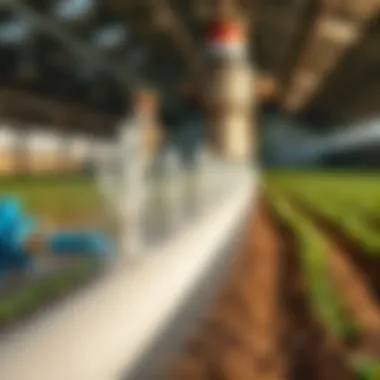Hydrofarm Pumps: Key to Modern Agricultural Success


Intro
In the realm of agriculture, efficiency and innovation hold significant value. As farming techniques evolve, so does the technology employed to ensure optimal productivity. Among these advancements, Hydrofarm pumps have emerged as indispensable tools, revolutionizing irrigation practices. In today’s article, we will examine the intricate role these pumps play in modern farming, their design features, and how they contribute to sustainable agricultural practices. By understanding the essential aspects of Hydrofarm pumps, farmers and enthusiasts can navigate the ever-changing landscape of agriculture more effectively.
Key Insights
Overview of the Topic
Hydrofarm pumps are designed to facilitate the movement of water and nutrients throughout the agricultural landscape. These pumps serve multiple purposes, from ensuring that plants receive adequate moisture to aiding in nutrient dispersal. With various types available, including submersible and surface pumps, their mechanisms can differ greatly based on the specific needs of the farm.
Importance in Agriculture/Horticulture/Agronomy
The impact of Hydrofarm pumps extends beyond mere convenience. They represent a shift towards enhanced productivity and resource management. By efficiently managing water supply, these pumps play a crucial role in:
- Optimizing irrigation schedules
- Minimizing water wastage
- Enhancing crop yield through precise nutrient delivery
- Supporting sustainable practices by utilizing eco-friendly methods
The relationship between a farmer and their pump is often one of dependency. A reliable Hydrofarm pump can mean the difference between a thriving crop and one that struggles to survive.
“In the world of agriculture, technology is not just a luxury; it is the lifeblood of survival.”
Sustainable Practices
Eco-Friendly Techniques
As agriculture becomes increasingly scrutinized for its environmental effects, many farmers are turning to sustainable practices. Hydrofarm pumps can be equipped with features that support eco-friendly methods, such as:
- Solar-powered options for energy efficiency
- Drip irrigation systems to reduce water consumption
- Advanced timers that schedule watering based on weather conditions
By incorporating these features into their farming practices, growers not only conserve resources but also comply with environmental regulations more effectively.
Case Studies on Sustainability
Examining real-world examples can shed light on the impact of using Hydrofarm pumps in sustainable farming endeavors. One notable case involves a vineyard in Napa Valley, California. By switching from traditional irrigation to a targeted drip system powered by Hydrofarm pumps, the vineyard successfully reduced water usage by nearly 40% while simultaneously enhancing grape quality. Such practices not only contribute to sustainability but also boost the overall economic viability of the farm.
Tools & Resources
Essential Equipment and Technologies
In modern agriculture, knowledge without tools is akin to a ship without a sail. To harness the full potential of Hydrofarm pumps, farmers should consider investing in:
- Flow controllers for accurate water delivery
- Pressure gauges to optimize system efficiency
- Maintenance kits to ensure longevity of the pumps
These components enable farmers to maintain control over their irrigation systems, leading to better crop outcomes.
Recommended Books and Readings
Knowledge is critical when it comes to effective agriculture. For those looking to deepen their understanding of farming technologies and Hydrofarm pumps, here are some recommended readings:
- Principles of Irrigation Engineering by B.C. Punmia
- Soil and Water Conservation Engineering by R. S. Varshney
- Sustainable Agriculture and the Future of Farming available on Britannica
By tapping into these resources, farmers can gain valuable insights to optimize their practices and embrace innovations like Hydrofarm pumps.
Prolusion to Hydrofarm Pumps
Understanding the role of Hydrofarm pumps is not just an academic exercise; it's a necessity in today’s agricultural landscape. These pumps, specifically designed for various applications within agriculture, are more vital than ever. As farmers and agricultural enthusiasts strive to optimize their output, hydropower technology becomes increasingly important. Without these pumps, the efficient distribution of water and nutrient solutions would be nearly impossible, hampering productivity and potentially jeopardizing crop yields.
Definition and Function
A Hydrofarm pump can be simply described as a mechanical device that facilitates the movement of liquids, predominantly water and nutrient mixtures, in agricultural contexts. Usually, these pumps are employed to distribute water through irrigation systems, support hydroponic setups, or even maintain water levels in aquaculture.
The fundamental function of these pumps is to ensure a steady flow of water to plants, optimizing their growth cycles. This includes not just the basic mechanics of moving water from one place to another but also ensuring that it reaches its destination with the needed pressure and volume. Further, the ability of these pumps to operate efficiently contributes to water conservation, a crucial consideration in modern farming practices.
Historical Context
The use of pumps in agriculture dates back centuries, but the advent of modern Hydrofarm pumps represents a significant evolution in this field. Historically, irrigation relied heavily on gravity-fed systems or manual labor. As agriculture advanced, the need for mechanized solutions became evident.
In the mid-20th century, with the rise of hydroponics and more intensive agricultural practices, specialized pumps like those from Hydrofarm were developed. These innovations responded to increasing demands for crop efficiency and yield, leading to greater emphasis on the technology that drives liquid movement in various forms. Today, one can hardly imagine a successful farming operation that neglects the sophisticated mechanisms and diverse types of Hydrofarm pumps available, such as submersible, surface, and diaphragm pumps.
In summary, the introduction of Hydrofarm pumps into the agricultural toolbox has revolutionized how water and nutrients are delivered to crops. The historical progression from manual to mechanized systems highlights not only an advancement in efficiency but also a profound change in agricultural practices. Understanding these facets sets a strong foundation for exploring the myriad applications and innovations these pumps offer in modern agriculture.


Understanding the Mechanics
The mechanics behind Hydrofarm pumps are integral to grasping their significance in modern agriculture. Understanding how these pumps function is not merely an academic exercise; it’s a matter of recognizing how these devices can enhance productivity and efficiency in agricultural practices. Whether it's irrigation or hydroponic systems, knowing the mechanics helps farmers make informed choices, ensuring optimal output and sustainability.
Hydrofarm pumps are at the heart of many agricultural systems. Their operation is influenced by various factors, including their components and the principles governing their mechanics. A deep dive into these aspects reveals essential insights on performance, efficiency, and even cost-saving measures.
Basic Components
Every Hydrofarm pump comprises several critical components, each playing a crucial role in its operation. These components include:
- Motor: The driving force, converting electrical energy into mechanical energy to move water.
- Impeller: A fan-like structure that helps in pushing water through the pump. Its design can significantly affect the pressure and flow rate.
- Pump Housing: This encases the internal parts, protecting them from external elements while allowing water to flow in and out.
- Seal and Shaft: These prevent leaks, ensuring efficiency by keeping water within the system and minimizing losses.
- Inlet and Outlet Ports: Designed for connecting the pump to the irrigation system, they direct water flow to where it is needed.
Together, these components work in unison to move water with precision, allowing for controlled distribution throughout various agricultural systems.
How Hydrofarm Pumps Operate
Hydrofarm pumps operate through principles that govern fluid dynamics. When the motor runs, it spins the impeller at high speeds, generating a centrifugal force that pushes water away from the center and towards the discharge port. This action creates a low-pressure area at the inlet, which draws more water into the pump.
In more practical terms, here's a step-by-step breakdown of the operational mechanism:
- Power Activation: The motor starts, initiating the pumping cycle.
- Fluid Movement: Water enters through the inlet due to the low pressure created by the impeller.
- Pressure Generation: As water moves through the impeller, centrifugal force increases its velocity and pressure.
- Water Discharge: Once pressurized, water exits through the outlet port, ready for distribution.
This efficient flow of water is critical for both agriculture and hydroponic setups, where precise water management can mean the difference between crop success and failure.
"Understanding these mechanics not only aids in troubleshooting but also empowers farmers to choose the right pump for their specific needs, enhancing overall efficiency in irrigation practices."
In the end, recognizing how these components fit together and the principles of operation helps farmers optimize their systems. It’s like knowing how each part of a clock ticks; when you understand the mechanics, you can keep everything running smoothly.
Types of Hydrofarm Pumps
The selection of the appropriate pump can make or break an agricultural operation. Hydrofarm pumps are quite essential, serving a myriad of roles in the sector. Understanding the different types of pumps available allows farmers and agricultural enthusiasts to choose the best suited for their needs. The right pump ensures optimal efficiency, ease of maintenance, and longevity of use.
Submersible Pumps
Submersible pumps, as the name implies, are designed to operate while submerged in the liquid they are pumping. This type of pump is typically used to draw water from wells or other deep sources. The beauty of submersible pumps lies in their ability to push water to the surface, instead of relying on suction like other pumps. As a result, they tend to be more efficient and can handle higher water pressure levels.
- Advantages:
- Energy Efficient: Because they are positioned underwater, they have lower energy costs compared to other types that must work against gravity.
- Reduced Noise: They operate quietly, making them ideal for residential farms as well.
- Space-saving: Their compact design allows them to be tucked away easily.
However, the challenges exist too. Regular maintenance is crucial, and if not done timely, these pumps can get clogged with debris or sediment.
Surface Pumps
Surface pumps draw water from a source that’s above ground, such as streams or irrigation canals. Unlike their submersible counterparts, these pumps rely on suction to bring water into the system. They are often utilized in applications where water needs to be moved over a distance, making them a popular choice in agricultural irrigation systems.
- Benefits:
- Versatility: Surface pumps can be used in various settings, including short or long-distance pumping.
- Easier Maintenance: They are generally easier to access for maintenance since they sit above ground.
- Cost-effective: They tend to be cheaper than submersible options.
On the flip side, surface pumps may struggle to lift water from deeper sources. Their efficiency is diminished in cases where long distances or steep elevations are involved.
Diaphragm Pumps
Diaphragm pumps operate with the help of a diaphragm that expands and contracts to create a vacuum. They can handle various liquids, including those with solid particles, which makes them quite popular among farmers dealing with slurry or various fertilizers. The adaptability of diaphragm pumps provides farmers with unique advantages for specific applications.
- Key Features:
- Versatility in Liquids: Ideal for thick liquids and slurries that can clog standard pumps.
- Self-Priming: Diaphragm pumps can often self-prime without the need for additional help.
- Durability: They tend to withstand harsh conditions, reducing the need for constant replacement.
While these pumps have many advantages, their flow rates can sometimes be lower compared to other types, and they can be more complex to maintain.
Overall, the type of Hydrofarm pump chosen can significantly affect the efficiency and effectiveness of agricultural practices. Each type has its own unique advantages and disadvantages, making it crucial for farmers to conduct thorough research before deciding on the best pump for their specific applications.
Applications of Hydrofarm Pumps
The versatility of Hydrofarm pumps plays a crucial role in modern agriculture. They provide essential support across various applications, enhancing both efficiency and productivity in farming operations. Understanding these applications allows farmers and agricultural enthusiasts to strategically implement hydroponic and irrigation systems, thereby optimizing crop yield and resource use. Here are some key areas where Hydrofarm pumps make a significant impact:
Agricultural Irrigation


Irrigation is the lifeblood of farming, especially in areas prone to drought or inconsistent rainfall. Hydrofarm pumps ensure a steady water supply to crops, helping to maintain healthy growth levels and optimize yields. These pumps can efficiently move water from reservoirs, lakes, or even underground aquifers to the fields, addressing several important factors:
- Water Efficiency: Reliable delivery systems can reduce water wastage, ensuring that every drop counts. Properly managed irrigation systems prevent overwatering, which can lead to waterlogged fields and diminished crop health.
- Customization: Farmers can tailor irrigation systems to suit specific crop needs, using different types of pumps to achieve desired watering schedules and volumes. For example, variable flow pumps can adapt to seasonal changes in water requirements.
"Water is the essence of life for both crops and farmers. Investing in an efficient pump guarantees that neither goes thirsty."
Hydroponic Systems
Hydroponics has gained traction as a revolutionary farming method, thriving without soil. Instead, plants grow in nutrient-rich solutions—here, Hydrofarm pumps are indispensable. They ensure that water mixed with fertilizers circulates effectively throughout the system. In hydroponic setups, several aspects come into play:
- Nutrient Delivery: The right pumps distribute nutrients evenly to all plants, which is crucial for their growth. Uneven nutrient distribution can lead to nutrient deficiencies or toxicities, harming vegetation.
- Environmental Control: Pumps control the flow rate and pressure of nutrient solutions, which in turn affects plant health. Too much pressure might damage plant roots, while too little can stunt their growth.
- Scalability: Hydrofarm pumps enable the expansion of hydroponic gardens—from small indoor systems to vast commercial operations.
Aquaculture Practices
Aquaculture relies on water quality and circulation for healthy fish populations. Hydrofarm pumps play a pivotal role in maintaining optimal living conditions for aquatic species. Here’s why they’re vital in aquaculture:
- Oxygenation: Pumps facilitate the aeration of water, which is key to fish health. Proper oxygen levels are essential for fish survival, growth, and overall well-being.
- Water Quality Management: By promoting proper circulation, these pumps aid in filtering waste and maintaining balanced water chemistry. This can prevent disease outbreaks and increase survival rates in fish populations.
- Temperature Regulation: In aquaculture, maintaining a consistent water temperature is important. Hydrofarm pumps help in circulating heated or cooled water to create an optimal environment for fish life.
Efficiency and Performance
In the dynamic world of agriculture, efficiency and performance are crucial metrics that determine the success of farming operations. The right choice in Hydrofarm pumps can enhance yield while conserving resources. As farming becomes increasingly competitive, understanding these aspects becomes vital for any farmer aiming to excel in today’s market.
Energy Consumption
One of the most pressing concerns for farmers is energy consumption. Operating pumps that consume excessive energy can inflate operational costs, cutting into profits. A well-chosen Hydrofarm pump minimizes energy use while maintaining adequate pressure and flow.
- Variable Frequency Drives (VFDs): These devices offer farmers the ability to control pump speed, thus matching the pump output requirements to the current system demand. This can lead to energy savings of up to 60% compared to rudimentary systems.
- Pump Efficiency Ratings: Electric pumps come rated for their efficiency under standard testing conditions. It's crucial to select pumps that provide the best performance ratings based on real-world requirements. A high-efficiency pump not only reduces energy costs but also enhances the operational life of the equipment.
Farmers should consider their specific energy contracts, as some electric providers offer better rates for off-peak usage, which can further optimize operating costs.
Water Delivery Rates
The ability to deliver water quickly and effectively directly impacts crop health. Hydrofarm pumps are designed to cater to various irrigation needs, from small gardens to vast agricultural fields. Each pump type has its unique flow characteristics.
- Flow Rate: Understanding flow rate is essential; how fast a pump can move water determines irrigation frequency and duration. For instance, a pump with a flow rate of 150 gallons per minute might be ideal for larger farms needing rapid water delivery.
- Head Pressure: This is the vertical distance a pump must move water, influencing both the pump’s energy needs and its potential elevation limits. Farmers must analyze their land’s topography to select pumps that provide adequate pressure at required flow rates.
In certain cases, using multiple pumps in a system allows for better water distribution across varying terrains, ensuring that all crops receive necessary moisture.
Durability Considerations
Durability is often a determining factor when investing in Hydrofarm pumps. Equipment can face quite a beating from harsh weather and constant use, leading to potential breakdowns. Thus, selecting a pump with a solid reputation for durability is a prudent choice.
- Materials and Construction: Pumps constructed from corrosion-resistant materials such as stainless steel not only stand the test of time but are also better equipped to handle various liquids involved in agricultural practices. More robust designs resist wear and tear and can handle high-pressure scenarios, thereby enhancing longevity.
- Maintenance Needs: A well-maintained pump is often a long-lasting pump. Some modern models incorporate features that simplify maintenance tasks, allowing farmers to keep their operations running smoothly without significant downtime.
“Investing in a quality pump isn’t just buying equipment; it’s buying peace of mind.”
A proactive approach to maintenance can stave off reliability issues and extend the lifespan of the equipment, ultimately improving the efficiency and performance of the irrigation system.
By placing a strong emphasis on energy consumption, water delivery rates, and durability, farmers can make informed decisions about their Hydrofarm pumps. These considerations lead to operational excellence, sustainability, and ultimately, better crop yields in the ever-demanding world of modern agriculture.
For more in-depth information on agricultural efficiency and pump technology, check resources from Wikipedia, Britannica, or industry-specific forums on Reddit.
Understanding these foundational concepts ensures farmers are equipped to face the challenges ahead.
Choosing the Right Hydrofarm Pump
Selecting an appropriate Hydrofarm pump is pivotal to ensuring effective water delivery in agricultural setups. The right pump not only maximizes water efficiency but also sustains the overall health of crops and systems. Choosing wisely can lead to significant benefits, including reduced operational costs and improved yield quality. It’s akin to choosing the right tool for a job; without the right fit, you might find yourself wrestling with inefficiency and frustration.
Factors to Consider
When standing at the crossroads of pump selection, there are several factors one must seriously weigh:
- Water Flow Requirements: Before dialing in on any specific model, first assess the quantity of water your crops need. More delicate plants may require softer delivery, while heavier irrigation systems might demand stronger pumps.
- Pressure Ratings: Every pump has a unique pressure rating that determines how far it can send water. Gage your needs carefully—if you’re operating in multi-level terrains, a pump with higher pressure capability is essential.
- Energy Efficiency: In today's climate, energy savings can’t be ignored. Look for pumps with energy-efficient ratings, as this can significantly lower consumption and costs over time.
- Maintenance Needs: Count on regular upkeep. Some pumps may require more frequent servicing than others. Choose one that aligns with your capability and commitment to maintenance.
System Compatibility
A pump is only as good as its harmony with the existing system. Compatibility affects both short- and long-term performance metrics significantly.
- Type of Irrigation System: Know your system. Whether you’re incorporating drip, sprinkler, or hydroponic setups, each may require a different kind of pump. For instance, submersible pumps work well in deeper systems, while surface pumps are perfect for horizontal delivery methods.
- Pipe Size and Length: Mismatching pipe sizes and lengths not only can cause pressure loss but can also lead to pump burnout. Check the specifications carefully. A 1-inch pump won't work properly in a system designed for 2-inch pipes.
- Integration with Existing Infrastructure: This includes evaluating the compatibility of the pump with controllers, sensors, and other technology throughout your operation.


Choosing a pump is a blend of art and science, requiring both empirical data and an intuitive understanding of your specific farming landscape.
Common Challenges
Navigating the world of Hydrofarm pumps isn’t always smooth sailing. Farmers and agricultural enthusiasts often encounter various hurdles that can disrupt their operations and productivity. Understanding these challenges is critical, as it can lead to better planning and informed decision-making in managing water flow systems.
System Failures
One of the primary concerns surrounding Hydrofarm pumps is the potential for system failures. This can occur due to a variety of factors, including power outages, mechanical issues, or even simple human error during setup. The impact of a failed pump system can be drastic; crops may suffer from insufficient watering, which could lead to lower yields or even crop failure.
- Power Outages: These can knock out electric pumps, causing an immediate halt in water delivery to essential areas of a farm. If the outage persists, especially during critical growth phases, the consequences can be dire.
- Mechanical Issues: Wear and tear over time is natural, but it’s crucial for operators to remain vigilant. Regular checks can prevent unexpected breakdowns.
- Human Error: Mistakes during installation or operation can lead to significant issues. Proper training is vital for anyone who works with these systems.
In essence, being proactive in identifying and mitigating these risks can save farmers a world of trouble. A well-planned maintenance schedule is not just a good practice; it’s an insurance policy against potential crop disasters.
Maintenance Issues
Maintenance is another area where farmers can incur challenges. Keeping a Hydrofarm pump in optimal condition requires attention and care. Unfortunately, routine maintenance often gets overlooked amid the daily demands of farming operations.
Several common maintenance issues can arise:
- Clogged Filters: Over time, debris and sediment can build up, reducing flow efficiency. Regular cleaning can prevent this from becoming a major hiccup.
- Leaking Seals: These can waste water and reduce system efficiency. Checking seals regularly will go a long way in ensuring everything remains tight and efficient.
- Wear of Parts: Pumps have a finite lifespan, and certain components wear out faster than others. Identifying these in a timely manner can save costs and extend the pump's overall life.
Maintaining equipment not only increases efficiency but also promotes sustainability in farming practices. Routine maintenance checks could mean the difference between a flourishing farm and one riddled with problems.
"Ignoring maintenance is like planting seeds in barren land; you reap what you sow."
Future Trends in Hydrofarm Pump Technology
The realm of hydroponics and modern agriculture is continuously evolving, and the technology surrounding Hydrofarm pumps is no exception. As the global agricultural landscape faces challenges like climate change, resource scarcity, and the increasing demand for food production, the importance of future trends in pump technology cannot be overstated. Understanding these advances is vital for anyone involved in farming or agricultural technology. With an ever-expanding toolbox of innovative solutions, farmers can increase efficiency, optimize resource use, and ultimately enhance crop yield in a sustainable manner.
Sustainable Innovations
Sustainability is at the forefront of global discourse, and hydroponic agriculture is no different. There's a growing push towards environmentally friendly innovations in pump technology. Manufacturers are developing pumps that minimize energy consumption while maximizing efficiency. For example, some companies are experimenting with materials that reduce weight and enhance durability, leading to longer-lasting products.
Additionally, solar-powered pumps are gaining traction. These systems can function off-grid, providing water even in remote areas, and drastically cutting down on electricity costs. Not only do these pumps contribute to the green energy movement, but they also allow farmers to remain resilient against fluctuating energy costs.
Another interesting trend is the use of biodegradable components. The adoption of such materials could result in a significant reduction of plastic waste in agricultural settings. It’s crucial that as we innovate, we opt for solutions that do not leave behind harmful traces in the environment. In turn, eco-friendly pumps empower farmers to adhere to sustainability standards while still maintaining productivity.
"Investing in sustainable pump technologies today not only benefits the environment but also prepares farmers for a more resilient tomorrow."
With these innovations on the rise, farmers are increasingly adopting pump systems designed for minimal water waste and optimized flow efficiency. Moreover, smart irrigation practices are being integrated with pump technology, allowing for better-aligned water usage with crop needs.
Integration of Smart Tech
As technology continues to weave itself deeper into agricultural practices, the integration of smart tech into hydroponic systems becomes a game changer. Imagine a pump system that constantly monitors its own efficiency, adjusting its activity based on real-time data. This is no longer science fiction; sensors that provide feedback on moisture levels, flow rates, and energy consumption are being incorporated into modern pump designs.
Using IoT (Internet of Things) capabilities, farmers can harness these data streams to make informed decisions quickly. Not only does this lead to enhanced resource management, but it also reduces the scope for human error. For instance, if a pump detects low water levels or blockages, it can alert the farmer immediately, potentially saving crops from drought or damage.
Further, some advanced systems enable remote monitoring and control through smartphones or tablets. This level of access can allow farmers to schedule watering times or adjust flow rates from virtually anywhere, freeing up time for other critical tasks. The adaptability of these smart systems will be essential as climate variability continues to affect growing conditions.
Moreover, predictive analytics, driven by big data, can analyze trends and predict future needs, contributing to long-term planning and crop management strategies. This could be invaluable in optimizing not just water usage, but also nutrient delivery to plants.
The incorporation of smart technology into Hydrofarm pumps won't just streamline operations. It represents a readiness to face the challenges of modern agriculture head-on. The potential to enhance productivity, cut costs, and promote environmental stewardship will resonate with farmers who strive to be successful and sustainable.
The road ahead for hydropump technology is paved with both sustainable practices and smart tech advancements. These trends stand to revolutionize the way farmers approach plant cultivation, allowing for a perfect blend of efficiency and ecological mindfulness. As agriculture continues to adapt and innovate, it's the farmers who embrace these changes who will effectively cultivate a fruitful future.
Culmination
In wrapping up our discussion on Hydrofarm pumps, it’s essential to highlight not just their functionality but their significance in shaping modern agricultural practices. These pumps are more than mere mechanical devices; they are integral components of efficient farming systems that ensure sustainable crop production and resource management.
Recap of Benefits
The benefits of utilizing Hydrofarm pumps are multifaceted and pivotal. Here’s a look at some of the key advantages:
- Efficiency in Water Use: Hydrofarm pumps optimize water delivery, minimizing waste and enhancing water conservation in irrigation practices.
- Versatile Applications: These pumps can be adapted for various uses, from traditional irrigation systems to advanced hydroponic setups, making them valuable across different farming styles.
- Increased Productivity: By providing reliable water supply, farmers can increase crop yields and ensure that crops receive the consistent nourishment they need.
- Durability and Reliability: Many Hydrofarm pumps are engineered to withstand harsh conditions, ensuring long-term performance and reducing the need for frequent replacements.
The collective impact of these benefits reflects a trend towards smarter, more responsible agricultural practices.
Final Thoughts
As we look to the future, the role of Hydrofarm pumps will likely evolve alongside advancements in technology and changing agricultural demands. The integration of smart technologies and sustainable innovations suggests a promising horizon for these devices. Farmers who embrace these developments will not only enhance their operations but also contribute to a broader movement towards sustainable agriculture.
The journey of understanding Hydrofarm pumps ultimately underscores a more extensive narrative about innovation in agriculture. By leveraging these tools, growers can navigate the complexities of modern farming while ensuring that they are equipped for the challenges that lie ahead.
For further information and a deeper dive into agricultural techniques, visit Wikipedia's Agriculture page or seek out forums like Reddit's Agriculture community. These resources can provide valuable insights and a platform for exchanging ideas among farming enthusiasts.







